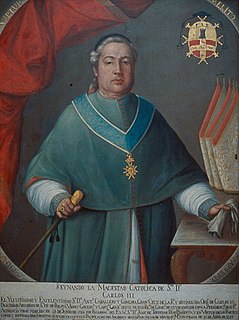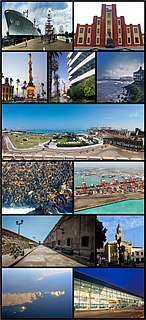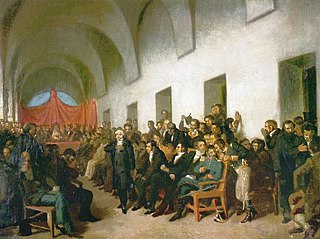The history of Paraguay is a result of development and interaction of varying cultures of indigenous peoples in Paraguay and overseas immigrants who together have created the modern-day Paraguay. Paraguay celebrates Independence Day on May 15, from 1811 to now.

José de Armendáriz y Perurena, 1st Marquis of Castelfuerte was a Spanish soldier and colonial administrator. From May 14, 1724 to February 4, 1736 he was viceroy of Peru.
José de Antequera y Castro was a Panamanian lawyer and judge in the Viceroyalty of Peru, and the leader of an insurrection in Paraguay against the viceroy and the king.

Gabriel de Avilés Itúrbide y del Fierro, 2nd Marquis of Avilés was a Spanish military officer and colonial administrator in the Americas. He was governor of Chile, viceroy of Río de la Plata, and viceroy of Peru.

Antonio Caballero y Góngora was a Spanish Roman Catholic prelate in the colonial Viceroyalty of New Granada, and from 1782 to 1789 the viceroy of New Granada.
Juan de Arregui was a Spanish Franciscan priest native of America and became Roman Catholic Bishop of Buenos Aires in 1730.
Military conflict in the Revolt of the Comuneros spanned from 1520 to 1521. The Revolt began with mobs of urban workers attacking government officials, grew to low-level combat between small militias, and eventually saw massed armies fighting battles and sieges. The comunero rebels gained control of most of central Castile quite quickly, and the royal army was in shambles by September 1520. However, the comuneros alienated much of the landed nobility, and the nobility's personal armies helped bolster the royalist forces. The Battle of Tordesillas in December 1520 would prove a major setback for the rebels, and the most important army of the comuneros was destroyed at the Battle of Villalar in April 1521.
Long before Spanish conquistadors discovered Paraguay for King Charles V in 1524, semi-nomadic Chaco Indian tribes populated Paraguay’s rugged landscape. Although few relics or physical landmarks remain from these tribes, the fact that nearly 90 percent of Paraguayans still understand the indigenous Guarani language is testament to Paraguay’s Indian lineage. The Spanish conquistadors arrived in 1524 and founded Asunción in 1537. Paraguay’s colonial experience differed from that of neighboring countries, such as Bolivia and Argentina, because it did not have gold and other mineral deposits that the Spanish were searching for. Because of its lack of mineral wealth and its remoteness, Paraguay remained underpopulated and economically underdeveloped. Early governor Domingo Martínez de Irala took an Indian wife and a series of Indian concubines and encouraged other male settlers to do likewise. Intermarriage fused Indian culture with that of the Europeans, creating the mestizo class that dominates Paraguay today. From the beginning, however, Indians retained their Guaraní language, even as Spanish influence was accepted, and embraced, in other aspects of society.

The history of yerba mate, that stretches back to pre-Columbian Paraguay, is marked by a rapid expansion in harvest and consumption in the Spanish South American colonies but also by its difficult domestication process, which even if discovered in the mid 17th century had to be rediscovered later when production was industrialized around 1900.
Below is a timeline of the history of Paraguay:
Diego de los Reyes y Balmaseda was the Governor of Paraguay from February 5, 1717 to August 20, 1721. His governorship was deeply unpopular with the inhabitants of Asunción, and an investigation by judge José de Antequera y Castro of the Real Audiencia of Charcas concluded that Reyes had abused his office, and he was deposed. Antequera took the governorship of Paraguay upon himself afterward, the beginning of the Revolt of the Comuneros. Reyes never recovered his governorship, and was eventually exiled from the province after a year-long imprisonment.
Gregorio de Hinestrosa was Governor of Paraguay from June 27, 1641 – February 2, 1647.
Diego de Escobar y Osorio was Governor of Paraguay from February 2, 1647 – February 22, 1649.
Bernardino de Cárdenas y Ponce, O.F.M., (1579?–1668) was a friar of the Franciscan order and Bishop of Asunción and later Santa Cruz de la Sierra. He served as Governor of Paraguay from March 4, 1649 – October 1, 1649. He ordered the first expulsion of the Jesuits from the Governorate of Paraguay, although this expulsion did not last; he was deposed as governor following a battle against the Jesuit armies.
Baltazar García Ros was a Navarrese-Spanish soldier and administrator. He was maestre de campo and interim governor of the Governorate of Paraguay from 1706 to 1707 and governor of the Governorate of the Río de la Plata from 1715 to 1717. During his career, he campaigned against the indigenous Charrua, Yaro, and Bohán people; the Portuguese; and the comunero rebels of Paraguay.
Ignacio de Soroeta was a Spanish administrator who was a corregidor in Cuzco and then briefly Governor of Paraguay in 1731. Soroeta's governorship is notable only in that it was in name only; he never ruled nor was accepted as governor within colonial Paraguay.
Martín de Barúa was a Spanish soldier and administrator in the Spanish Empire. He served as Lieutenant Governor of Santa Fe between 1714–1716 and 1717–1722, and as Governor of Paraguay between 1725–1730. Under his direction as governor, the cities of Carapeguá and Itauguá were founded, in May 14, 1725 and June 27, 1728, respectively.









